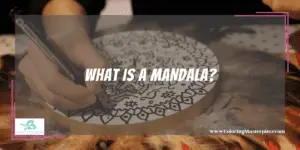Art is a form of therapy. People seek out ways to express their feelings on a piece of paper or canvas. It lets out all the negative energy so that there is a positive picture at the end. This isn’t a new concept, many people have been using art therapy for hundreds of years. So, have therapists; have their clients express their emotions in a positive, constructive way, through art. One method that is used is called Mandala Art Therapy.
Mandala Art Therapy is psychotherapy used by therapists to guide their clients through a variety of artistic processes using geometric shapes. It is used to find or restore a sense of healthy mental balance. It can be used to treat patients who suffer from depression and anxiety.
Now, you don’t need to be seeing a therapist to use this method of therapy. It is pretty easy to create on your own and to be used when it is needed. So, how can you create mandala art, and how does it help with treating depression and anxiety? Well, you’re about to find out.
What is a Mandala?

‘Mandala” comes from the ancient Sanskrit word, meaning, circle. However, the word mandala does have a meaning beyond a simple shape. Mandalas represent a wholeness of life, unity to exist among living things, and a world in which we all co-exist. They are used in many cultural, and spiritual traditions. You have probably seen a mandala and you don’t even know that you are looking at it; think of everything that you have seen with a pattern within a circle. For example:
- Flowers
- Fruit
- Tree Rings
- Human Cells
- Planet Earth
- Solar System
- Milky Way Galaxy
Using Mandala Art Therapy
Many have used mandala art therapy to capture all the feelings of anger, depression, anxiety, and fear. It is a therapeutic way to create something beautiful all the while getting rid of those negative feelings. The most interesting part of mandala art therapy is that it is used to capture and provide a snapshot of the emotional state of the creator. Some create a mandala art therapy journal that provides the creator’s emotional state over time; so, you can track their progress.
How to Create Mandala Art
If you are having issues connecting to art, such as using a coloring book, or painting, as a therapy outreach, maybe you should try something different. Everyone is different when it comes to connecting with art, and using it to let out some negative energy. Maybe using Mandala is what you need. If you feel that this could be a helpful tool in your life and want to learn more about how to create a mandala, here are some steps to follow to do so:
- Be sure to mediate first. Take a few minutes to close your eyes and focus on your breathing. You want to clear your mind, to start with a clean slate.
- Take your mandala circle to start. You can use crayons, markers, etc to create your art within the circle. Start to doodle, try not to think about what you are creating, and let your hands, brain, and feelings take the wheel. You want to fill the entire circle.
- The circle may be filled with things that you saw during your meditation. Or it can be filled with shapes and colors.
- When you are finished you should see a whole picture of your emotional state as the creator or a particle look of the narrator’s emotional state.
- Translate your work.
Check out more articles on mandala coloring HERE.
How to Translate Your Mandala Artwork
Of course, you want to know what is the meaning of what you created. You wouldn’t have done it if you didn’t There are different ways to translate your work, but you want to be sure to ask yourself a few questions as you do so:
Questions to Ask Yourself:
- Do you see any patterns or themes? Are there any hotspots or ignored spots within the circle?
- Do you see anything that can relate to your past or current problems? Do you see anything about the future?
- Do you see any parts that represent yourself?
- Any negative influences or blocked energies?
- Any unhealed wounds, trauma, or pain?
- Do you see any of your hopes and dreams?
- What colors did you use and their meanings? To find that out you can look up color psychology, and get some answers.
- Are there any unique shapes or lines that stand out?
- Does the artwork create a story?
- Look at it in its entirety, does it create a whole picture?
What are the Healing Benefits of Mandala Art Therapy?

Imagery is a form of meditation. As we all know meditation is great for healing; it can be used as a tool to restore and enlighten our bodies. Using mandala art as a form of therapy can create a different state of mind that allows us to evaluate Alpha points. Alpha points are waves that help us to learn new materials more easily and change old habits. In simpler terms, it is a change of state of mind that has a positive effect and involves our bodies.
If you have ever done meditation on your own, you know how hard it is to discipline yourself to keep the focus on your breathing and counting. Some people have issues doing that. Their minds can wander to things they may have to get done that day, issues that they are having in their life, or maybe lingering in their past.
To meditate, you need to focus and not think about all the negative things that are going on around you. Most people use guided meditation; this can be a YouTube video, maybe calming music to keep their mind busy, or mandala art. Mandala art therapy can be used as guided therapy to get out the negative thoughts, concerns, and anxieties. It has been one of the top ways for people who normally can’t meditate on their own, but maybe don’t want to listen to someone talking to them through meditation. It is a creative way to connect with what is going on in your life as well as your body.
Steps Before Getting Started
- Allow thirty minutes to an hour for the creation process. Be sure that nothing is going to distract you or interfere with the therapy.
- Take a few moments to breathe deeply, and to become centered.
- Start with a dot. Because they contain geometric and organic shapes it is a great starting point for it to be repetitive and reflective.
- Draw a cross through the dot, making four quadrants. And if you want to make eight sections, draw another diagonal.
- Once your sections are created, contain them in a circle, and meditate on them.
- Be sure to be in a comfortable position and you want to be sure to enjoy the spiritual process.
- Once you are completed, try to interpret the meanings of your drawing and find the emotional state you currently have.
Conclusion
Using mandala art therapy can be great for anyone who is looking to meditate, control their depression, anxieties, and fears, or maybe create something different than they are used to. Mandala has been used for years as a treatment, and style in the therapy and meditation world. The patterns of mandalas can be found in tapestry, paintings, and everyday life, such as flowers, fruits, etc. Be sure to be on the lookout while you are out and about next time. You may see them more than you think.
Be sure to use this therapy efficiently; if you want it to work, or you want to document your progress, you want to be sure that you are doing it correctly. With the steps shown in this article, anyone, from beginners to experts can create and use mandalas creatively and positively. Be sure to share your creations!
Frequently Asked Questions
What are Mandalas Used for in Therapy?
Traditionally, they are used in Eastern spiritual traditions to aid meditation. It has been used in many different cultures in the Eastern world to create self-awareness and balance. In the West use mandala with mental health counselors, to ease stress, anxiety, and depression. It is a great tool to use the negative energy one may have in a positive outlet.
Do Mandalas Have Different Meanings?
In short terms, yes they do; Mandala offers a balance of visual elements, symbolizing unity and harmony. The meanings depend on color, geometric shape, and culture. Mandela’s main goal is to record a spiritual journey within the creator’s mind put down on paper, canvas, or any other creative place to draw, color, and create.
What do Mandala Colors Mean?
To start, red is the means of strength, energy, and passion. Pink has the meaning of love, intuition, and the feminine. Orange represents creativity, transportation, self-awareness, and intuition. Yellow represents laughter, learning, wisdom, and happiness. Green has the meanings of, physical healing, psychic ability, love of nature, and caring.
Maximize the benefits of coloring with my free adult coloring eBook and by signing up for my email newsletter HERE!
Disclaimer: The information provided by ColoringMasterpiece.com (“The Site”) is for general informational purposes only. All information on the Site is provided in good faith, however, we make no representation or warranty of any kind, express or implied, regarding the accuracy, adequacy, validity, reliability, availability, or completeness of any information on the Site. Under no circumstance shall we have any liability to you for any loss or damage of any kind incurred as a result of the use of the Site or Reliance on any information provided on the Site. Your use of the Site and your reliance on any information on the Site is solely at your own risk. This blog post is for educational purposes only and does not constitute legal advice. Please consult a legal expert to address your specific needs.
Terms and Conditions: https://coloringmasterpiece.com/terms-and-conditions/
